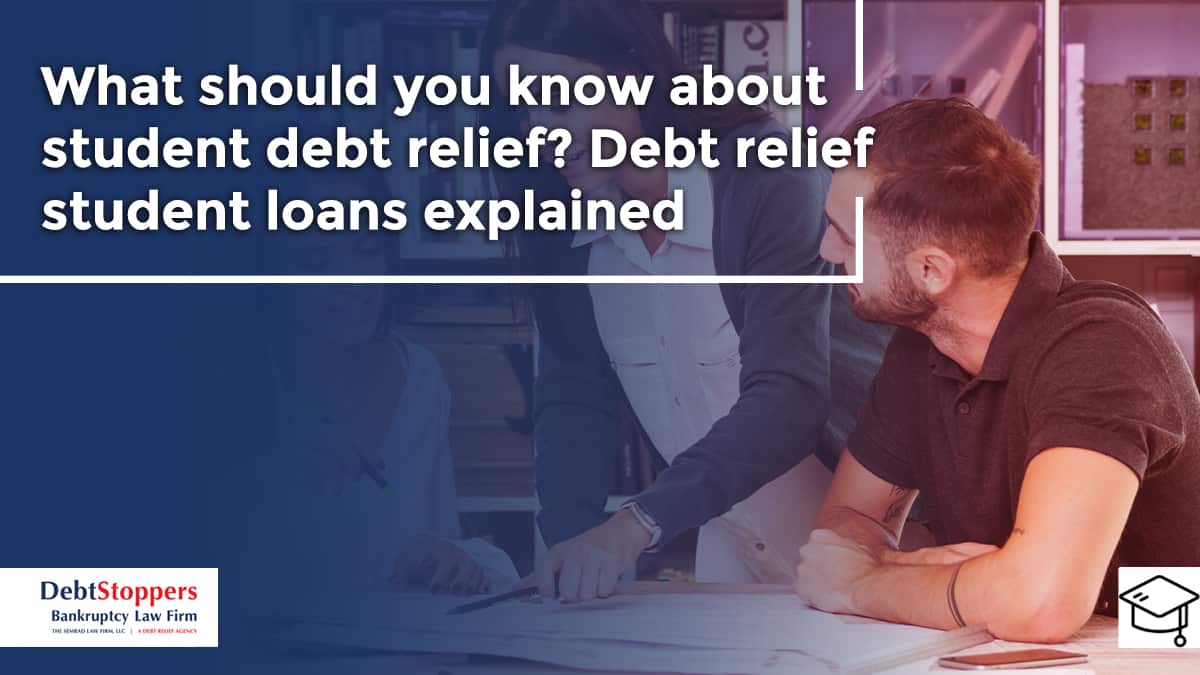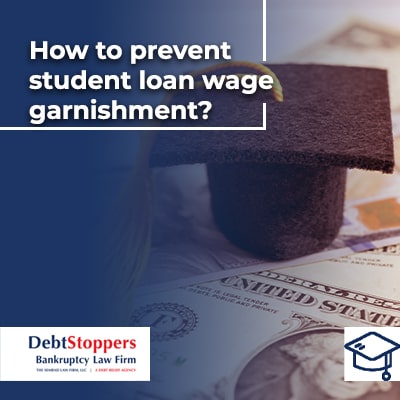What should you know about student debt relief? Debt relief student loans explained

There are several programs that provide student debt relief. Some common types of student loan debt relief include income driven repayment plans, public service and teacher loan forgiveness programs, loan consolidation, and loan rehabilitation.
Each program has unique eligibility requirements and application processes. While student debt relief programs can lower monthly payments, reduce the total amount repaid over time, and provide loan forgiveness it is important to also consider potential consequences in enrolling in certain programs, such as extended repayment terms, tax implications for forgiven debt, and the impact on credit.
It is important to understand the options available for student debt relief and carefully evaluate eligibility requirements and program benefits that can help borrowers effectively manage their student loan debt and work toward financial stability. The following guide explains the basics of student debt relief.
What is student debt relief and how does it work?
Several student debt relief programs and strategies are available to help borrowers manage and reduce their student loan debt burden. These programs provide financial assistance, lower monthly payments, or offer loan forgiveness options. Some common programs include:
Public Service Loan Forgiveness (PSLF) forgives the remaining balance on Direct Loans after borrowers have made 120 qualifying payments while working full-time for a qualifying employer, such as government agencies or non-profit organizations.
Teacher Loan Forgiveness offers loan forgiveness of up to $17,500 for eligible teachers who teach full-time for five consecutive years in certain low-income schools or educational service agencies.
Income-Driven Repayment Plans (IDRs) adjust borrowers' monthly payments based on their income and family size, making them more manageable. Examples include Income-Based Repayment (IBR), Pay As You Earn (PAYE), and Revised Pay As You Earn (REPAYE). Borrowers may be eligible for loan forgiveness after making payments for a certain time period.
Loan Consolidation allows borrowers to consolidate multiple federal student loans into a single Direct Consolidation Loan. This simplifies repayment and may lower monthly payments by extending the repayment term. However, it may also increase the total amount repaid due to accruing interest over a longer period.
Loan Rehabilitation helps borrowers remove default status from their student loans by making nine consecutive on-time payments within ten months. Once rehabilitated, borrowers regain eligibility for benefits like deferment, forbearance, and income-driven repayment plans.
Refinancing involves obtaining a new private student loan to pay off existing loans, typically with a lower interest rate and/or different repayment terms. However, refinancing federal loans with a private lender forfeits federal loan benefits and protections.
Borrowers should research and understand the eligibility requirements, terms, and potential consequences of each student debt relief program. Several programs have specific eligibility criteria and may not be suitable for all borrowers.

Who can qualify for student loan debt relief?
Qualification for student loan debt relief depends on various factors, including the type of relief program and the borrower's circumstances. Here's a general overview of who may qualify for different types of student loan debt relief:
Public Service Loan Forgiveness (PSLF) - Borrowers working full-time for qualifying employers, such as government organizations or non-profit organizations, may qualify for PSLF. To qualify, borrowers must make 120 qualifying payments under a qualifying repayment plan while working full-time for a qualifying employer. Eligible loans include Direct Loans, and borrowers must be enrolled in an income-driven repayment plan to maximize forgiveness under PSLF.
Teacher Loan Forgiveness - Teachers working full-time for five consecutive years in certain low-income schools or educational service agencies may qualify. Depending on the subject area taught and other factors, eligible teachers may receive forgiveness of up to $17,500 on their Direct Subsidized and Unsubsidized Loans and Subsidized and Unsubsidized Federal Stafford Loans.
Income-Driven Repayment Plans (IDRs) - Borrowers with federal student loans may qualify for IDRs if their monthly payments under a standard repayment plan are high relative to their income. Qualification typically depends on factors such as income, family size, and the types of federal student loans. Most federal student loan borrowers are eligible for at least one IDR plan, such as Income-Based Repayment (IBR), Pay As You Earn (PAYE), Revised Pay As You Earn (REPAYE), or Income-Contingent Repayment (ICR).
Loan Consolidation - Borrowers with federal student loans may qualify for Direct Consolidation Loans to consolidate multiple loans into a single loan with a new repayment term and interest rate. Most federal student loans are eligible for consolidation, including Direct Loans, Federal Family Education Loans, and Perkins Loans.
Loan Rehabilitation - Borrowers in default on federal student loans may qualify for loan rehabilitation by making nine consecutive on-time monthly payments within ten months. Successful rehabilitation removes the default status from the loans and restores eligibility for benefits like deferment, forbearance, and income-driven repayment plans.
Refinancing - Borrowers with federal and/or private student loans may qualify to refinance their loans with a private lender to secure a lower interest rate and/or different repayment terms. Eligibility for refinancing depends on factors such as income, creditworthiness, employment status, and debt-to-income ratio.
It's important to review the specific eligibility criteria and requirements of each student loan debt relief program and consult with their loan servicer or a professional for personalized guidance.
What are the consequences of defaulting on your student debt?
Defaulting on student debt can have serious consequences that can negatively impact a borrower's financial well-being and creditworthiness. Some potential consequences of defaulting on student loans include wage garnishment, damage to your credit score, collection actions, tax refund offsets, loss of federal benefits, difficulty obtaining credit, negative impact on co-signers, and other legal consequences.
Defaulting on student loans can have long-lasting consequences that can significantly impact a borrower’s future opportunities. To prevent defaulting on student loans, borrowers facing financial difficulties should explore options for managing their student loan debt, such as income-driven repayment plans, deferment, forbearance, or loan rehabilitation, to avoid default and mitigate the associated consequences.

How to prevent student loan wage garnishment?
To prevent student loan wage garnishment there are several steps you can take to address being delinquent or defaulting on your student loan debt. Here are some strategies to prevent or stop wage garnishment for student loans:
If you are struggling to pay your student loans, contact your loan servicer as soon as possible. They can provide information about repayment options, such as income-driven repayment plans, deferment, or forbearance, which may help you avoid default and wage garnishment.
If you're experiencing financial hardship or other circumstances preventing you from making payments on your student loans, you may be eligible for deferment or forbearance. These options temporarily pause or reduce your monthly payments, giving you time to improve your financial situation.
If your loans are already in default, consider loan rehabilitation as a way to remove the default status and stop wage garnishment. Loan rehabilitation involves making a series of consecutive on-time payments to restore your loans to good standing.
If you're facing wage garnishment or legal action for defaulted student loans, consider seeking legal assistance from a qualified attorney specializing in student loan law. An experienced attorney can help you understand your rights, explore available options, and potentially negotiate with your loan servicer to prevent or stop wage garnishment.
By taking proactive steps to address your student loan debt, you can prevent or stop wage garnishment and regain control of your financial situation. It's essential to explore all available options and seek assistance to find a solution that works for you.
What is wage garnishment?
Wage garnishment is a legal process that allows a portion of an individual's wages to be withheld by their employer to satisfy a debt owed to a creditor. In the context of student loans, wage garnishment is a mechanism used by the government to collect overdue federal student loan payments.
Before wage garnishment begins, the borrower receives notification from the loan servicer or collection agency regarding the delinquent or defaulted status of their student loans. This notice informs the borrower of the intention to garnish wages if the debt remains unpaid. In the case of federal student loans, wage garnishment typically does not require a court order. Instead, the Department of Education or its designated collection agencies can initiate administrative wage garnishment without a court judgment.
Once wage garnishment is authorized, the loan servicer or collection agency sends an order to the borrower's employer instructing them to withhold a certain percentage of the borrower's wages from each paycheck. The employer deducts the specified amount from the borrower's wages and sends it directly to the loan servicer or collection agency to satisfy the debt.
Federal law limits the amount that can be garnished from a borrower's wages for student loan debt. Generally, the garnishment cannot exceed 15% of the borrower's disposable income, or the amount by which the borrower's weekly income exceeds 30 times the federal minimum wage, whichever is less.
It's essential to address delinquent or defaulted student loans proactively to avoid wage garnishment. Borrowers facing financial hardship or difficulty making payments should contact their loan servicer to explore repayment options, such as income-driven repayment plans, deferment, or forbearance, to prevent or stop wage garnishment.
Who can help you with figuring out your student debt relief?
Several resources and professionals can assist borrowers in navigating student debt relief options and understanding their eligibility for various programs. Some resources that can help you figure out your student debt relief include:
Loan Servicer - You can start by contacting your loan servicer, the company responsible for managing your student loans. Loan servicers can provide information about available repayment plans, loan forgiveness programs, deferment, forbearance, and other options.
U.S. Department of Education - The Department of Education's Federal Student Aid (FSA) office offers resources, tools, and information about federal student loan programs and repayment options. You can visit the FSA website or contact the Federal Student Aid Information Center for assistance.
Student Loan Ombudsman - If you are experiencing difficulties with your student loans or facing disputes with your loan servicers, you can seek assistance from the Student Loan Ombudsman's office. The Ombudsman can help resolve complaints, provide information about borrower rights and responsibilities, and offer guidance on navigating the student loan system.
Certified Student Loan Counselors - Certified student loan counselors can provide personalized guidance and assistance in understanding repayment options, eligibility requirements, and navigating the student loan relief process. Nonprofit organizations, credit counseling agencies, and community organizations may offer free or low-cost counseling services.
Financial Advisors - Certified financial advisors or planners can provide comprehensive financial guidance, including strategies for managing student loan debt, optimizing repayment plans, and integrating student loan repayment into broader financial planning goals.
Attorneys - Attorneys specializing in student loan law or consumer rights can offer legal advice and representation for borrowers facing complex student loan issues, disputes, or legal challenges. It’s important to note that in 2022, the Department of Education updated bankruptcy guidelines to make it easier for people to get their student loans erased in bankruptcy court. Previously, it was difficult, if not impossible, for people to get their student debt discharged through bankruptcy. The experienced attorneys at Debtstoppers can help you understand your options, negotiate on your behalf, and if appropriate help you discharge your student loans through bankruptcy.





